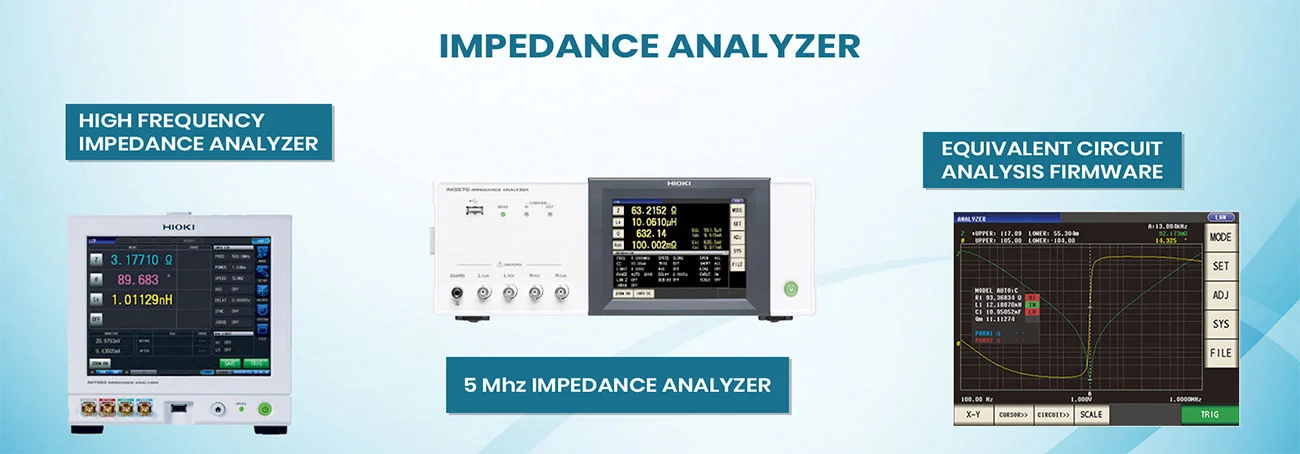What is an impedance?
Impedance measurement can be said the measuring how much a circuit resists the passage of electricity. Because all substances have a certain amount of electrical resistance, some energy gets wasted as heat and the flow of current gets reduced. In the case of the direct current (DC), impedance is the same as resistance and is purely determined by the materials used to construct the circuit.
However, in the case of alternating current (AC), two additional elements might contribute to impedance: capacitance and inductance. These are usually defined as reactance, which refers to the measure of resistance to a change in current that varies with frequency and circuit components.
Analysis of Impedance Measurement Products:
Sensors, electrochemical cells, electronic components, and materials are mostly developed, characterized, and tested using impedance measuring devices. They may extract complicated impedance vectors in a single test condition or while scanning source parameters like frequencies, amplitude, and dc bias.
What is LCR Meter?
L represents inductance, C represents capacitance, and R represents resistance. LCR meters are the devices that measure these characteristics.
A digital LCR meter measures I via the Device Under Test and V across the Device Under Test, as well as the phase angle between the measurement of I and V. These measured characteristics are for deriving meaningful impedance parameters. In addition, an LCR meter is for the measurement of impedance, which is then transformed to L, C, or R for display.
LCR meters and impedance meters are for the test and confirming the impedance of electrical components at specific frequencies or across a wide frequency range. If the impedance is not within the requirements, the circuit will not function properly.
Measuring Impedance with LCR Meter:
An LCR meter may be useful for determining the impedance of any inactive component. Electrical impedance, denoted by the symbol Z, varies with circuit component and frequency application in alternating current.
It is a sort of complete division that occurs in the alternating current path. It consists of inductive, resistive, and capacitive reactance. An LCR meter may be useful in evaluating the impedance of a circuit.
It is greatly accomplished by putting the meter’s leads out across endpoints of the component for measurement. The results are then shown on an LCD or LED display.
LCR meter Impedance measurement products:
For more than a half-century, Hewlett Packard, Agilent, and Keysight have pioneered inventions and high-quality products in impedance analysis. Impedance measurement products take delight in contributing to your success, whether it is in R&D, quality assurance, manufacturing, or incoming inspection.
Service providers attempt to give complete solutions to satisfy your demands, from impedance scanners to a wide range of test accessories, for various impedance measurement goods in Delhi. Companies have found success with impedance-measuring products.
Precautions while using Impedance Measurement Products:
The impedance measurement is a difficult procedure in which recorded values frequently fail to stabilize. The following are some possible reasons for this problem:
The parasitic components of the measured components
Components have parasitic components that generate variability in measured values in addition to the design values for resistance and reactance. Even changes in the length of the leads connecting the components, as well as the distance between them, might cause measured values to differ.
Variability resulting from the evaluation of elements
Individual variations among the components for tested influence impedance measurement. Even when taking measurements under identical conditions, it is often hard to duplicate measured quantities.
Variability produced by the context for the employment of the device
Changes in the measurement environment, such as the temperature of inductors and capacitors at the moment of the measurement, probe capacitance, and, when monitoring high-impedance parts, external inductive noise, all affect measured results. Furthermore, readings might be easily influenced by DC bias in the circuit under test or the instrument.
Averaging numerous measurements, for example, is mainly required to prevent variation in impedance measurement.
Conclusion:
Impedance meters are usually classified according to their measuring methodologies, frequency ranges, and other characteristics. You’ll need to specify the types of measurements you’ll be taking so that you may select the appropriate impedance meter.
You’ll also need to take procedures like repeating test measurements since several factors induce variability in impedance measurement. Impedance measurement products provide great ease during taking measurements.


